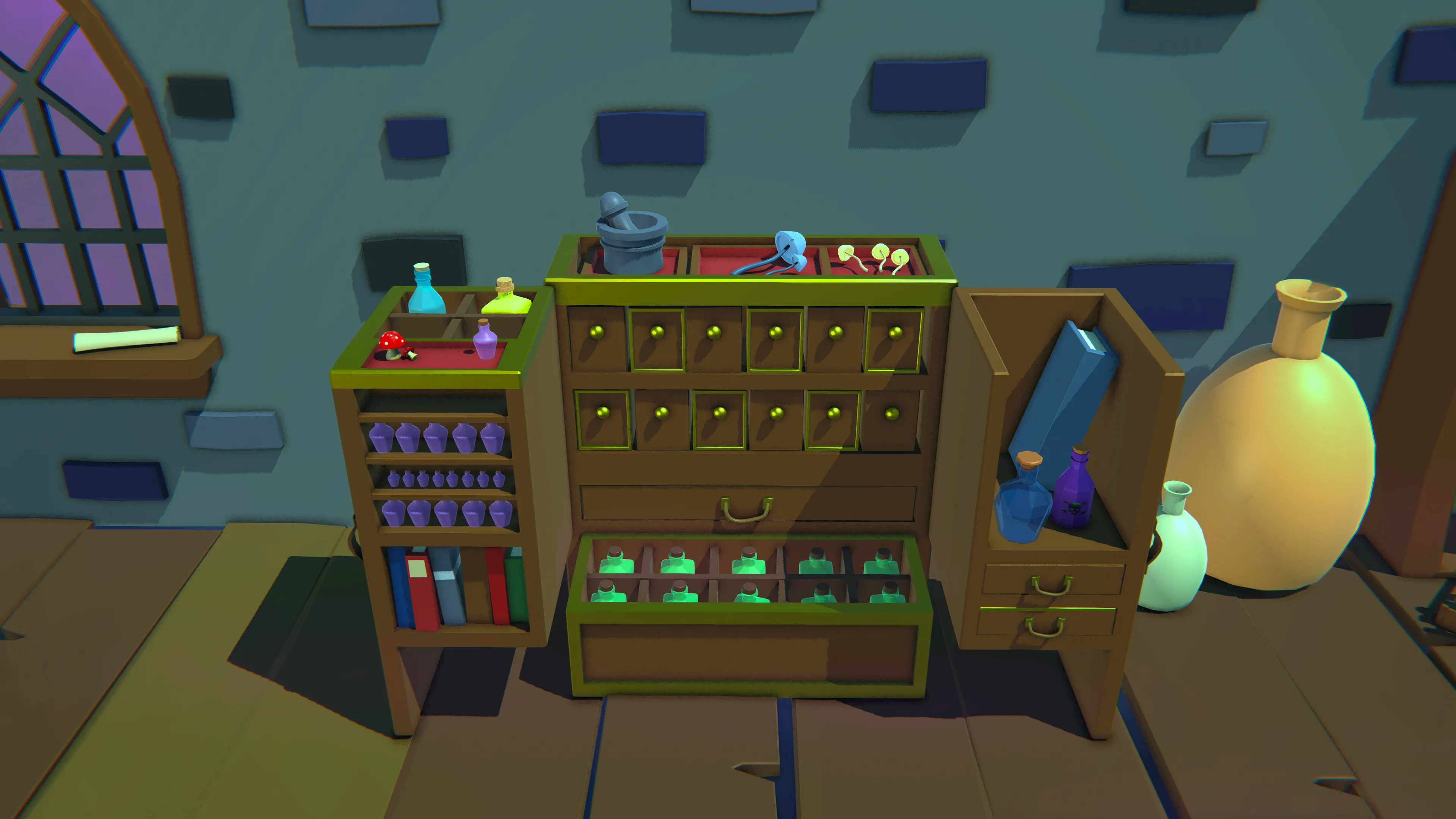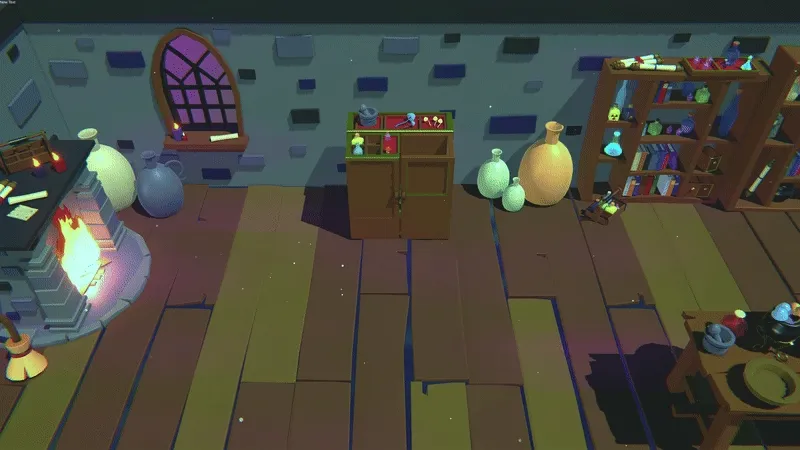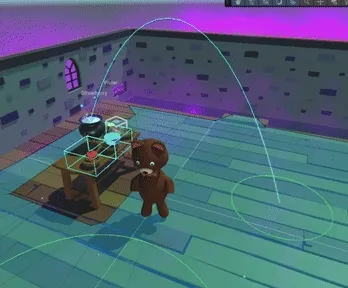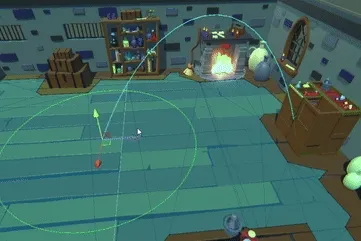
Storage Chest - AlchemisTeddy 🧪🐻
This animated low-poly alchemist’s chest is designed for real-time gameplay.
The model uses flat colors to ensure clear readability of interactive elements, while hand-painted details
(potion bottle, mushroom) highlight secondary features for added clarity and interest.
The animation was implemented with gameplay integration in mind, showcasing both technical setup and artistic direction.
Optimized for performance, this asset represents an early test of the art–code pipeline within a larger playable WIP project.
This game-ready asset is composed of 3 scripts and an animator system as explained below.
Script
The chest functionality relies on three primary scripts:
- TreasureChest.cs – handles activation, damage, and persistence.
- ItemSpawner.cs – spawns items along a parabolic arc with visual feedback.
- ChestAnimator.cs – links the chest’s open/close state to an Animator.
This separation ensures modularity: each script has a clear responsibility, making the system easy to extend or reuse.
TreasureChest.cs
The TreasureChest script implements multiple small interfaces
(IActivatable, IDamageable, ISaveable) to define its behavior without forcing unused methods.
It controls:
- Opening/closing in response to player interaction.
- Item spawning when opened.
- Damage handling via TakeDamage.
- State persistence for saving/loading game sessions.
Examples
Toggling the chest open state and spawning items is handled elegantly with events:
/// <summary>
/// Activates the chest component
/// </summary>
/// <param name="activator"></param>
public void Activate(GameObject activator)
{
// Return if chest has health
if (currentHealth > 0) return;
OnChestChangeState?.Invoke(isOpen = !isOpen);
if (items.Count > 0)
{ // Spawn Items in the items list
foreach (ItemData item in items)
{
itemSpawner.SpawnItem(item);
}
items.Clear();
}
}

Persistence is managed through a lightweight string-based serialization system, mapping item IDs back to assets at load time:
public Dictionary<string, string> CaptureState()
{
List<string> itemIDs = items.Select(item => item.ItemID).ToList();
string itemStateString = string.Join(",", itemIDs);
return new Dictionary<string, string>
{
{ "isOpen", isOpen.ToString() },
{ "items", itemStateString }
};
}
This design demonstrates clean event-driven programming, modularity, and runtime + persistent state management without bloating the script.
ItemSpawner.cs
ItemSpawner allows items to be launched along a customizable parabolic arc, providing dynamic feedback to the player.

Key features include:
- Randomized landing positions within a radius.
- Configurable arc height and travel duration.
- Coroutine-based movement with optional trail effects.
- Editor Gizmos for setup visualization.
Example
This code snippet show how the arc is drawn in the Editor with Gizmos.
/// <summary>
/// Draws Gizmos in the editor when the object is selected to visualize the spawn trajectory.
/// </summary>
private void OnDrawGizmos()
{
// Ensure we have a spawn point to draw from.
if (spawnPoint == null) return;
// --- Draw the Landing Zone ---
Handles.color = Color.green;
// The third parameter is the "normal" or the direction the circle should face. Vector3.up makes it flat on the XZ plane.
Handles.DrawWireDisc(landingPoint.position, Vector3.up, landingRadius);
// --- Draw the Arc Path ---
Gizmos.color = Color.cyan;
Vector3 previousPoint = spawnPoint.position;
// Loop through a number of steps to draw the arc.
for (int i = 1; i <= gizmoPathResolution; i++)
{
// Calculate the 't' value (normalized progress) for this step.
float t = (float)i / gizmoPathResolution;
// Use the same math as the coroutine to calculate the point on the arc.
Vector3 linearPosition = Vector3.Lerp(spawnPoint.position, landingPoint.position, t);
float arc = 4 * arcHeight * (t - (t * t));
Vector3 currentPoint = linearPosition + new Vector3(0, arc, 0);
// Draw a line from the previous point to the current one.
Gizmos.DrawLine(previousPoint, currentPoint);
previousPoint = currentPoint;
}
}
This system is modular, so any item with a prefab can be launched without additional scripting, and designers can adjust trajectories visually in the editor.

Animation
Chest animations are handled by a small, dedicated script: ChestAnimator.cs. Its job is simple but crucial: respond to chest state changes and update the Animator parameters.
public void OpenChest(bool value)
{
animator.SetBool(isOpenHash, value);
}
The animator listens to the same OnChestChangeState event from TreasureChest.cs, ensuring decoupling between gameplay logic and animation.
This event-driven approach allows the animation system to be reused or swapped without touching the chest’s core logic.
Optimization
A small but important optimization is applied in the animation system:
void Start()
{
isOpenHash = Animator.StringToHash("isOpen");
}
By caching the parameter hash once at startup, the script avoids repeated string lookups each frame. This is much more performant in real-time gameplay, especially when multiple chests exist in the scene. It’s a simple change that demonstrates attention to both technical efficiency and scalable design.
Design Considerations
This setup demonstrates modular, scalable architecture:
- TreasureChest: gameplay logic, persistence, damage.
- ItemSpawner: visual and interactive feedback for items.
- ChestAnimator: purely visual animation tied to game state.
By separating responsibilities and using events, the system is robust, easy to debug, and ready to extend with new features such as alternative animations, loot systems, or multiplayer synchronization.
Conclusion
The alchemist’s storage chest is more than a decorative prop, it’s a fully integrated gameplay system.
- The scripts handle activation, durability, persistence, and item spawning, making the chest modular and adaptable to different design needs.
- The animation system cleanly ties into gameplay events, with optimizations that ensure smooth, scalable performance in real-time scenes.
Together, these elements show how art and code converge in a single prefab. The chest is readable, performant, and ready for integration into a larger playable environment, demonstrating a pipeline that balances technical rigor with creative direction.